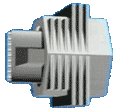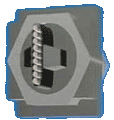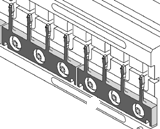
 Matrix printing is the most respectable, according to the age, process, that still enjoys its popularity. The technology is simple: to receive an image, dots are applied to the paper. These dots are made by the printing head needles when they hit the paper through the ink ribbon. Needles are gathered in vertical rows. There are two types of printers according to the number of needles: 9 needle printers (where the printing head has one row with 9 needles) and 24 needle printers (where the printing head has two rows with 12 needles in each one). There are printers with 18 needles in printing head. Such heads are used in high-speed printers. In these heads, needles are arranged rhombic. Such an arrangement provides high-speed printing with the equal force of impact on the central and the outer needles. The printing quality of this printer fully complies with the printing quality of 9 needle printer. The “excess” of the needles is used for increasing the speed, but not the quality (it is known, that the printing quality of the 24 needle printer is noticeably higher than the quality of 9 needle one).
Matrix printing is the most respectable, according to the age, process, that still enjoys its popularity. The technology is simple: to receive an image, dots are applied to the paper. These dots are made by the printing head needles when they hit the paper through the ink ribbon. Needles are gathered in vertical rows. There are two types of printers according to the number of needles: 9 needle printers (where the printing head has one row with 9 needles) and 24 needle printers (where the printing head has two rows with 12 needles in each one). There are printers with 18 needles in printing head. Such heads are used in high-speed printers. In these heads, needles are arranged rhombic. Such an arrangement provides high-speed printing with the equal force of impact on the central and the outer needles. The printing quality of this printer fully complies with the printing quality of 9 needle printer. The “excess” of the needles is used for increasing the speed, but not the quality (it is known, that the printing quality of the 24 needle printer is noticeably higher than the quality of 9 needle one).
 When at work, the printing head moves along the bogie and the needles are sequentially shooting out and leaving dots on the paper, by which the image is being formed (usually it is letters and numbers, but printing graphics is possible as well). According to the way of forming the image, traditional matrix printers are called SIMD devices (Serial Impact Dot-Matrix). And line matrix printers may be considered as “not traditional” matrix printers. Line matrix printers are quite massive devices. In large organizations, people usually replace alphameric printers that went out of order and style with them. The image rendering concept they use is quite different from the one described above.
When at work, the printing head moves along the bogie and the needles are sequentially shooting out and leaving dots on the paper, by which the image is being formed (usually it is letters and numbers, but printing graphics is possible as well). According to the way of forming the image, traditional matrix printers are called SIMD devices (Serial Impact Dot-Matrix). And line matrix printers may be considered as “not traditional” matrix printers. Line matrix printers are quite massive devices. In large organizations, people usually replace alphameric printers that went out of order and style with them. The image rendering concept they use is quite different from the one described above.

 The base of a line matrix printer (in terms of Printronix printers) is so called shuttle (to your left): the body is made with the printer wide bed, and along all of this bed there are printing hammers (on the picture to your right – there are hammers which are combined in modules called frets). During the printing, that part of the shuttle where the hammers are, makes in-and-out movements with the great frequency and amplitude that is equal to the distance between neighboring hammers (usually – few millimeters), and this part is driven by crank mechanism of the shuttle. Depending on the speed of the printer, different types of frets with different amount of hammers are used (the higher the speed, the bigger amount of hammers in frets).
The base of a line matrix printer (in terms of Printronix printers) is so called shuttle (to your left): the body is made with the printer wide bed, and along all of this bed there are printing hammers (on the picture to your right – there are hammers which are combined in modules called frets). During the printing, that part of the shuttle where the hammers are, makes in-and-out movements with the great frequency and amplitude that is equal to the distance between neighboring hammers (usually – few millimeters), and this part is driven by crank mechanism of the shuttle. Depending on the speed of the printer, different types of frets with different amount of hammers are used (the higher the speed, the bigger amount of hammers in frets).
 Moving from one blind spot to the other, each hammer, if needed, strikes the paper through the ribbon, what reveals the horizontal line of your image. After that, the paper is fed one step forward and the shuttle goes in the opposite direction (look at the animation to your left). Thus, the image is formed on the paper line by line. That’s why, the speed of printing here is not measured in symbols per second, like with the usual SIDM printer, but in lines per second (as for the text), or in inches per second, if you print graphic images. The ribbon moves either one or the other direction during the printing, and winds from the one bobbin to another (like in the old fashioned typing machines). It is installed at an angle with the bed with the hammers, what gives the ability to wear it down evenly. Although, the same thing gives the ability to wear down the ribbon unevenly. It may happen in case you print mainly on narrow paper (A4 pages), which causes the wearing of only the half of the ribbon (you can see that on the picture shown below), and the second half will stay untouched. If this kind of printing is really necessary, it is recommended to flip the bobbins from time to time, so you will bring the one side of the ribbon to work today and the other one tomorrow.
Moving from one blind spot to the other, each hammer, if needed, strikes the paper through the ribbon, what reveals the horizontal line of your image. After that, the paper is fed one step forward and the shuttle goes in the opposite direction (look at the animation to your left). Thus, the image is formed on the paper line by line. That’s why, the speed of printing here is not measured in symbols per second, like with the usual SIDM printer, but in lines per second (as for the text), or in inches per second, if you print graphic images. The ribbon moves either one or the other direction during the printing, and winds from the one bobbin to another (like in the old fashioned typing machines). It is installed at an angle with the bed with the hammers, what gives the ability to wear it down evenly. Although, the same thing gives the ability to wear down the ribbon unevenly. It may happen in case you print mainly on narrow paper (A4 pages), which causes the wearing of only the half of the ribbon (you can see that on the picture shown below), and the second half will stay untouched. If this kind of printing is really necessary, it is recommended to flip the bobbins from time to time, so you will bring the one side of the ribbon to work today and the other one tomorrow.

 There are two types of technologies, which are setting in motion the needle or the hammer of the matrix printer– it is ballistic technology (to your left) and the stored energy printing technology (to your right). Ballistic technology is based upon electromagnets which are located in each one of the needles. When the electromagnet is being powered, it draws the needle “butt” (things may vary according to the manufacturer) and the needle starts moving. The needle is drawn back by the spring force. And in stored energy technology, there is a constantly curved spring in the each needle head, that is held by the permanent magnet.
There are two types of technologies, which are setting in motion the needle or the hammer of the matrix printer– it is ballistic technology (to your left) and the stored energy printing technology (to your right). Ballistic technology is based upon electromagnets which are located in each one of the needles. When the electromagnet is being powered, it draws the needle “butt” (things may vary according to the manufacturer) and the needle starts moving. The needle is drawn back by the spring force. And in stored energy technology, there is a constantly curved spring in the each needle head, that is held by the permanent magnet.
When the winding, that is made with the permanent magnet, is being powered, creates a small magnetic field, and it compensates the power of the permanent magnet. This compensation is just enough for the spring to tear off the magnet, and for the fastened needle to start moving. When the power is off the winding, the spring goes back to the permanent magnet, what draws the needle to the primary position. Ballistic technology is older, stored energy thechnology is newer. The main advantages over ballistic technology, is that during the work, the head is heated less (to compensate the power of a magnet, less power is needed to be given to the coil, unlike when the electric magnet moves the needle by itself), besides, the impact force of a needle in the stored energy head, depends only on the hardness of the bent spring, and that means that the force is not changed during the time and because of the heating. From the other side, the ballistic printing heads are smaller, and that allows to save the energy during moving the heads along the bobbin, and also to make more powerful heatexangers on them.
Being the oldest technology, home users are not still interested in matrix printing as they used to be. But, there are fields of application where the matrix printing cannot be replaced: printing of multi-instance forms (custom bonds and consignment notes); printing pin-envelopes for SIM cards and bank cards; printing plane tickets; printing of very important blanks and forms, the not only the printed information matters, but the fact of printing the information by impact.
Source: http://kudesnik.net/
